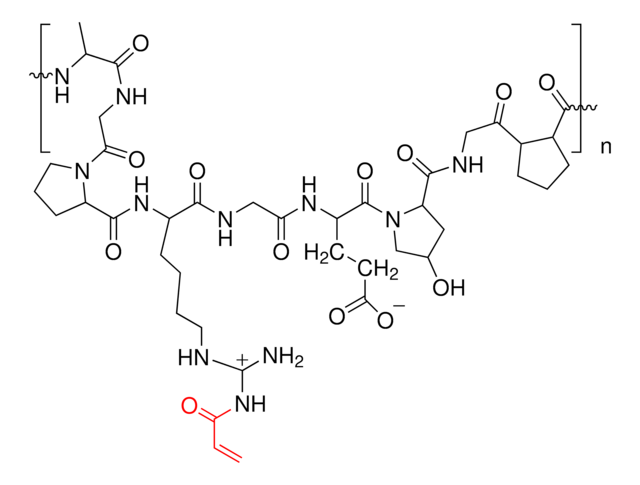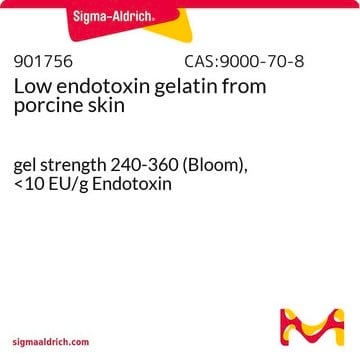추천 제품
애플리케이션
Gelatin methacrylate can be used to form cross-linked hydrogels for tissue engineering and 3D printing. It has been used for endothelial cell morphogenesis, cardiomyocytes, epidermal tissue, injectable tissue constructs, bone differentiation, and cartilage regeneration. Gelatin methacrylate has been explored in drug delivery applications in the form of microspheres and hydrogels.
Storage Class Code
11 - Combustible Solids
WGK
WGK 3
Flash Point (°F)
Not applicable
Flash Point (°C)
Not applicable
시험 성적서(COA)
제품의 로트/배치 번호를 입력하여 시험 성적서(COA)을 검색하십시오. 로트 및 배치 번호는 제품 라벨에 있는 ‘로트’ 또는 ‘배치’라는 용어 뒤에서 찾을 수 있습니다.
이미 열람한 고객
Facile one-step micropatterning using photodegradable methacrylated gelatin hydrogels for improved cardiomyocyte organization and alignment.
Tsang K, et al.
Advances in Functional Materials, 25(6), 977-986 (2015)
Covalent attachment of a three-dimensionally printed thermoplast to a gelatin hydrogel for mechanically enhanced cartilage constructs.
Boere KWM, et al.
Acta Biomaterialia, 10(6), 2602-2611 (2014)
Photocrosslinkable gelatin hydrogel for epidermal tissue engineering.
Zhao X, et al.
Advanced Helathcare Materials (2015)
Jason W Nichol et al.
Biomaterials, 31(21), 5536-5544 (2010-04-27)
The cellular microenvironment plays an integral role in improving the function of microengineered tissues. Control of the microarchitecture in engineered tissues can be achieved through photopatterning of cell-laden hydrogels. However, despite high pattern fidelity of photopolymerizable hydrogels, many such materials
Ruohong Shi et al.
Small (Weinheim an der Bergstrasse, Germany), 16(37), e2002946-e2002946 (2020-08-11)
Hydrogels with the ability to change shape in response to biochemical stimuli are important for biosensing, smart medicine, drug delivery, and soft robotics. Here, a family of multicomponent DNA polymerization motor gels with different polymer backbones is created, including acrylamide-co-bis-acrylamide
문서
Discussion of synthetic modifications to gelatin, improving the three-dimensional (3D) print resolution, and resulting material properties.
Professor Shrike Zhang (Harvard Medical School, USA) discusses advances in 3D-bioprinted tissue models for in vitro drug testing, reviews bioink selections, and provides application examples of 3D bioprinting in tissue model biofabrication.
프로토콜
Frequently asked questions (FAQs) for KAPA SYBR® FAST One-Step qRT-PCR Kits.
자사의 과학자팀은 생명 과학, 재료 과학, 화학 합성, 크로마토그래피, 분석 및 기타 많은 영역을 포함한 모든 과학 분야에 경험이 있습니다..
고객지원팀으로 연락바랍니다.









